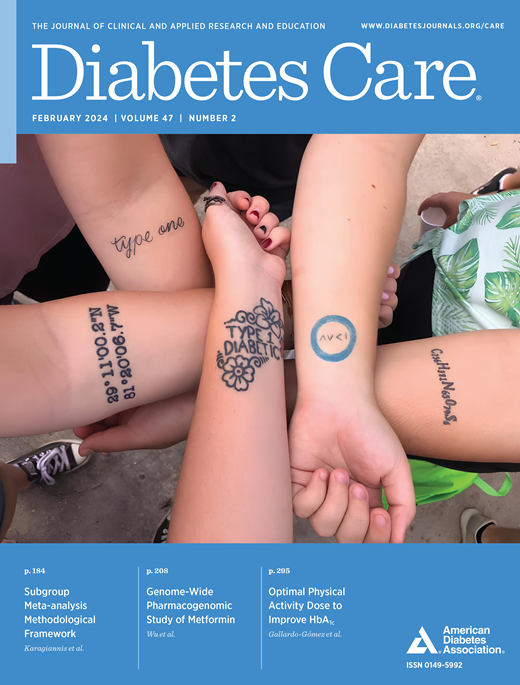Timing of Moderate to Vigorous Physical Activity, Mortality, Cardiovascular Disease, and Microvascular Disease in Adults With Obesity
IF 16.6
1区 医学
Q1 ENDOCRINOLOGY & METABOLISM
引用次数: 0
Abstract
OBJECTIVE To assess the association between timing of aerobic moderate to vigorous physical activity (MVPA) and risk of cardiovascular disease (CVD), microvascular disease (MVD), and all-cause mortality in adults with obesity and a subset with obesity and type 2 diabetes (T2D). RESEARCH DESIGN AND METHODS Participants included adults with obesity (BMI ≥30 kg/m2) and a subset of those with T2D from the UK Biobank accelerometry substudy. Aerobic MVPA was defined as bouts of MVPA lasting ≥3 continuous minutes. Participants were categorized into morning, afternoon, or evening MVPA based on when they undertook the majority of their aerobic MVPA. The reference group included participants with an average of less than one aerobic MVPA bout per day. Analyses were adjusted for established and potential confounders. RESULTS The core sample included 29,836 adults with obesity, with a mean age of 62.2 (SD 7.7) years. Over a mean follow-up period of 7.9 (SD 0.8) years, 1,425 deaths, 3,980 CVD events, and 2,162 MVD events occurred. Compared with activity in the reference group, evening MVPA was associated with the lowest risk of mortality (hazard ratio [HR] 0.39; 95% CI 0.27, 0.55), whereas afternoon (HR 0.60; 95% CI 0.51, 0.71) and morning MVPA (HR 0.67; 95% CI 0.56, 0.79) demonstrated significant but weaker associations. Similar patterns were observed for CVD and MVD incidence, with evening MVPA associated with the lowest risk of CVD (HR 0.64; 95% CI 0.54, 0.75) and MVD (HR 0.76; 95% CI 0.63, 0.92). Findings were similar in the T2D subset (n = 2,995). CONCLUSIONS Aerobic MVPA bouts undertaken in the evening were associated with the lowest risk of mortality, CVD, and MVD. Timing of physical activity may play a role in the future of obesity and T2D management.肥胖症成人适度到剧烈运动的时间、死亡率、心血管疾病和微血管疾病
目的 评估肥胖症成人以及肥胖症和 2 型糖尿病(T2D)患者中,有氧中度到剧烈运动(MVPA)的时间与心血管疾病(CVD)、微血管疾病(MVD)和全因死亡率风险之间的关系。研究设计与方法 参与者包括英国生物库加速度子研究中的肥胖成人(体重指数≥30 kg/m2)和二型糖尿病患者。有氧 MVPA 的定义是连续≥3 分钟的 MVPA。根据参与者进行大部分有氧 MVPA 的时间,将他们分为上午、下午或晚上 MVPA 组。参照组包括平均每天少于一次有氧 MVPA 的参与者。分析对已确定的和潜在的混杂因素进行了调整。结果 核心样本包括 29,836 名肥胖成人,平均年龄为 62.2 岁(标准差为 7.7 岁)。在平均 7.9(SD 0.8)年的随访期间,有 1425 人死亡,3980 人发生心血管疾病,2162 人发生中毒性心血管疾病。与参照组的活动相比,晚间 MVPA 与最低的死亡风险相关(危险比 [HR] 0.39;95% CI 0.27,0.55),而下午(HR 0.60;95% CI 0.51,0.71)和上午 MVPA(HR 0.67;95% CI 0.56,0.79)显示出显著但较弱的相关性。心血管疾病和中风的发病率也有类似的模式,晚间 MVPA 与心血管疾病(HR 0.64;95% CI 0.54,0.75)和中风(HR 0.76;95% CI 0.63,0.92)的最低风险相关。T2D 子集(n = 2,995)的研究结果与此类似。结论 傍晚进行有氧 MVPA 与死亡率、心血管疾病和心血管疾病风险最低有关。体育锻炼的时机可能会在未来的肥胖和 T2D 管理中发挥作用。
本文章由计算机程序翻译,如有差异,请以英文原文为准。
求助全文
约1分钟内获得全文
求助全文
来源期刊

Diabetes Care
医学-内分泌学与代谢
CiteScore
27.80
自引率
4.90%
发文量
449
审稿时长
1 months
期刊介绍:
The journal's overarching mission can be captured by the simple word "Care," reflecting its commitment to enhancing patient well-being. Diabetes Care aims to support better patient care by addressing the comprehensive needs of healthcare professionals dedicated to managing diabetes.
Diabetes Care serves as a valuable resource for healthcare practitioners, aiming to advance knowledge, foster research, and improve diabetes management. The journal publishes original research across various categories, including Clinical Care, Education, Nutrition, Psychosocial Research, Epidemiology, Health Services Research, Emerging Treatments and Technologies, Pathophysiology, Complications, and Cardiovascular and Metabolic Risk. Additionally, Diabetes Care features ADA statements, consensus reports, review articles, letters to the editor, and health/medical news, appealing to a diverse audience of physicians, researchers, psychologists, educators, and other healthcare professionals.
 求助内容:
求助内容: 应助结果提醒方式:
应助结果提醒方式:


